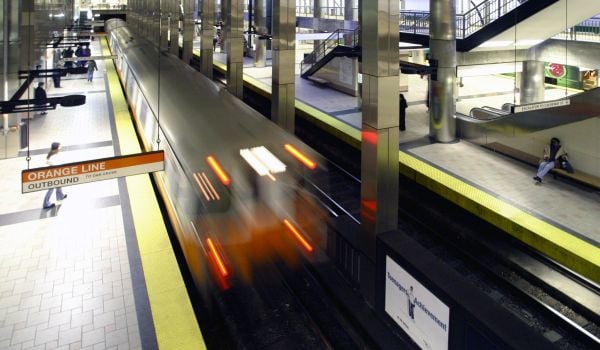Welcome to “The Mobile City,” our weekly roundup of new and newsworthy transportation developments.
A grassroots advocacy group in Pittsburgh recently managed to drive a large stake through the heart of a proposal for a transportation corridor that would rely on autonomous shuttles.
But killing one ill-conceived micromobility project doesn’t mean that micromobility is a bad idea. On the contrary, the growth of on-demand minibus service and electric-powered personal transport shows that it has a promising future ahead of it. New York City is taking another step into that future with the arrival of the city’s first e-scooter sharing network in a section of the Bronx.
Meanwhile, on the macromobility front, one of the commuter rail services that got sidelined by COVID-19, New Mexico’s Rail Runner, will resume service between New Mexico’s largest city, its suburbs and its state capital this month, and San Diego reached an environmental milestone last month when it retired the last of its diesel buses.
Pittsburgh Transit Advocates Kill a “No-Good, Very Bad” Microtransit Proposal, It Appears
While the counties surrounding Pennsylvania’s second-largest city remain economically depressed, as they have been since the decline of the region’s steelmaking industry, Pittsburgh itself is on a roll, fueled largely by high-tech research and development sparked at the city’s two leading universities, the University of Pittsburgh and Carnegie Mellon University.
Those two neighbors in the city’s east-side Oakland neighborhood have designs on a former steel mill site to their south along the banks of the Monongahela River. Now called Hazelwood Green, the 178-acre site is owned by a partnership backed by three major Pittsburgh foundations and being touted as a locus of high-tech enterprise and inclusive, equitable redevelopment that would also bring benefits to the underinvested Hazelwood neighborhood surrounding it.
In 2015, the City of Pittsburgh applied for a “Smart City” grant from the U.S. Department of Transportation to help it build a “mobility corridor” connecting Oakland with Hazelwood Green. The corridor project would consist of pedestrian and bike paths through one edge of the city’s Schenley Park, then passing through Four Mile Run and Greenfield on the way to Hazelwood. Included in this project was a proposal for an autonomous shuttle route with seven stations that would have paralleled the corridor.
“Would have” because in December, the Pittsburgh City Council voted to redirect some $4.1 million it had committed to the “Mon-Oakland Mobility Corridor” to support affordable housing, assist small businesses and make street and sidewalk improvements in Hazelwood.
Thus ended a multi-year fight against the project launched by the user advocacy group Pittsburghers for Public Transit (PPT), which had worked with Hazelwood residents caught by surprise when they learned about the proposal from a Pittsburgh Post-Gazette report on the grant application in 2015. A new article in Transit Center titled “Pittsburghers Versus the Machine” describes how PPT worked with local residents to first develop an alternate vision for the area, then persuade the City Council to shift its focus from building the corridor to delivering on improvements Hazlewood residents had long sought.
PPT referred to the Mon-Oakland Mobility Corridor as “A Terrible, No-Good, Very Bad Project” in its own campaign against it, saying it failed as transportation, promoted displacement, misused public funds in a cash-strapped city, destroy part of a beloved city park and completely ignored residents’ concerns and desires.
The vote to redirect the $4.1 million the city had budgeted for the project in fiscal 2021 hasn’t completely killed the proposal, which is still in the design phase and also got tacked onto a stormwater-management and flood-control plan that would benefit Hazelwood residents. But it does make its chance of proceeding as planned far less likely, and it does mean that the city is unlikely to fork over all of the $23.1 million that the project would have cost the city over its entire lifespan. (The stormwater-management part will likely survive.)
PPT executive director Laura Wiens told Transit Center, “The Mon-Oakland Connector is just the most egregious example of the city’s prioritization of transportation projects that are designed to increase profits for private developments, or to provide public resources to support venture-backed mobility services.” PPT even developed its own alternative plan for improving transit in the area. Called “Our Money. Our Solutions,” it focused on improving the quality and frequency of bus service to Hazelwood by beefing up an existing bus route and extending another.
E-Scooter Sharing Comes to New York
New York was one of the early adopters of bike-sharing, and its Citi Bike network has become a fixture in the city’s transportation system. The New York Post now reports that the next big thing in shared personal mobility has finally arrived in the city.
According to the report, the New York City Department of Transportation (NYCDOT) is launching a pilot e-scooter share program that will deploy 2,000 to 3,000 motor-assisted kick-scooters in an 18-square-mile area of the northeast Bronx that includes the neighborhoods of Co-op City, Eastchester, Pelham Parkway and Wakefield this spring.
“We are happy to deliver the city’s first e-scooter share pilot — crafted to allow Bronx residents to try e-mobility to and from countless critical destinations, from Co-op City to the Soundview NYCFerry terminal,” NYCDOT Commissioner Hank Gutman said in a statement.
The report does not list the companies that will provide the scooters for the pilot program, but it does state that NYCDOT will require the providers to keep sidewalks and pedestrian ramps clear of vehicles and track all crashes.
The pilot program is connected to a push by New York’s City Council to legalize the use of e-bikes and e-scooters on city streets. The territory covered by the pilot avoids overlap with existing areas served by Citi Bike.
The RailRunner Burns Up the Tracks in New Mexico Again Starting This Month
New Mexico’s commuter/regional rail line derives its name from the official state bird, the roadrunner, made famous beyond the Land of Enchantment in animated cartoons from the 1960s. But COVID-19 threw Rail Runner service off track — the train operating between Belen, south of Albuquerque, and the state capital of Santa Fe to Albuquerque’s north has been out of service since March 15 of last year. Now Railway Age reports that the Rail Runner Express will once again sprint up the I-25 corridor beginning March 8.
Rio Metro Transit District, which operates both the Rail Runner and bus service in the Albuquerque area, will run a “commuter-oriented” schedule that includes about half the number of weekday trains that had run prior to the COVID shutdown. Passengers will also be limited to no more than 25 percent of the trains’ capacity. Riders who had purchased monthly tickets before the shutdown may reactivate them for use this month, and last year’s annual passes will be prorated.
Five of the 15 stations on the 97-mile line will remain shuttered for the time being, weekend service will not resume yet, and cash will not be accepted as fare payment.
Rio Metro used the downtime to install positive train control and run occasional trains to keep operating crews sharp.
“We are very excited to start running passenger service again,” Dewey V. Cave, Rio Metro’s executive director, told Railway Age. “We are happy to be resuming operations of this much-valued transportation option for many in central New Mexico, and above all, we want people to feel safe while traveling on the Rail Runner.”
Albuquerque resident J.W. Madison, president of the advocacy group New Mexico Rails, curbed his enthusiasm a bit. “This beats the hell out of no revenue service, or killing the train altogether, which would have made some elements in our state pretty happy,” he told Railway Age. “Although New Mexico Rails, Inc. would have liked to see this glad event occur sooner, it must be said that Rio Metro has used its down time wisely; getting PTC up and running, and refitting the cars for greater medical safety. We’re looking forward like kids before Christmas to the resumption of full service.”
San Diego Retires Its Last Diesel Buses
San Diego has become the first major metropolis in the United States to eliminate diesel buses from its transit vehicle fleet. An article in Metro magazine reports that the San Diego Metropolitan Transit System (MTS) took its last diesel buses out of service and added two more battery-electric buses to its roster.
In addition to buying the two electric buses, MTS bought 24 compressed-natural-gas-powered (CNG) commuter buses from Motor Coach Industries (MCI) to replace the diesels on express runs from San Diego’s eastern suburbs to downtown.
“MTS retiring the last of its diesel buses from its fixed-route fleet is a monumental leap forward in air quality,” said Nathan Fletcher, MTS Board chair and chair of the San Diego County Board of Supervisors, in the article. “It represents our commitment to environmental justice, sustainability, air quality and to being one of the leaders nationally in achieving these ambitious environmental standards.”
MTS was the first transit system in the country to incorporate CNG buses into its fleet, buying its first such vehicles 20 years ago.
The two Gillig battery-electric buses bring the total number of electric-powered buses in the MTS fleet to eight. The agency began its pilot zero-emission-vehicle program in 2017 and has set 2040 as the target date for transitioning to a 100-percent zero-emission fixed-route vehicle fleet.
Know of a development that should be featured in this column? Send a Tweet with links to @MarketStEl using the hashtag #mobilecity.

Next City contributor Sandy Smith is the home and real estate editor at Philadelphia magazine. Over the years, his work has appeared in Hidden City Philadelphia, the Philadelphia Inquirer and other local and regional publications. His interest in cities stretches back to his youth in Kansas City, and his career in journalism and media relations extends back that far as well.
Follow Sandy .(JavaScript must be enabled to view this email address)
















